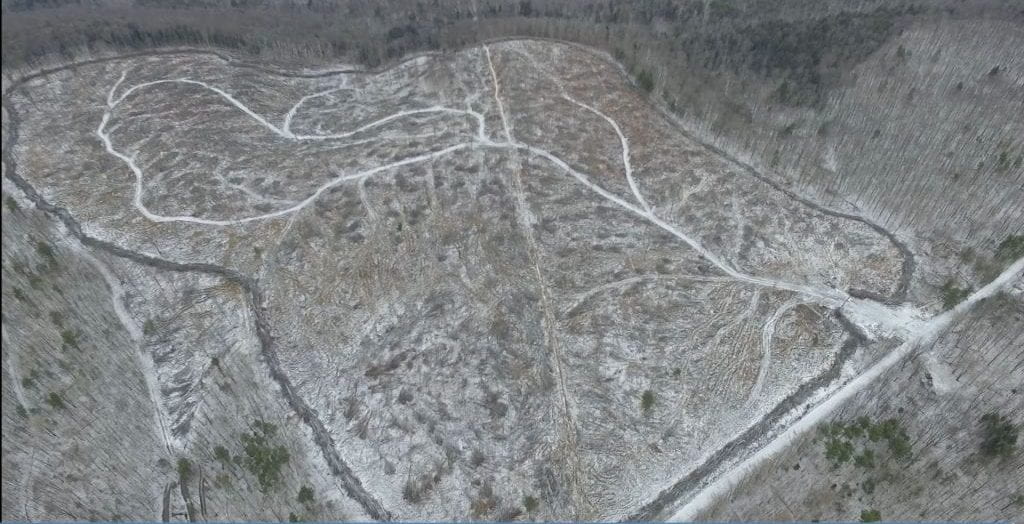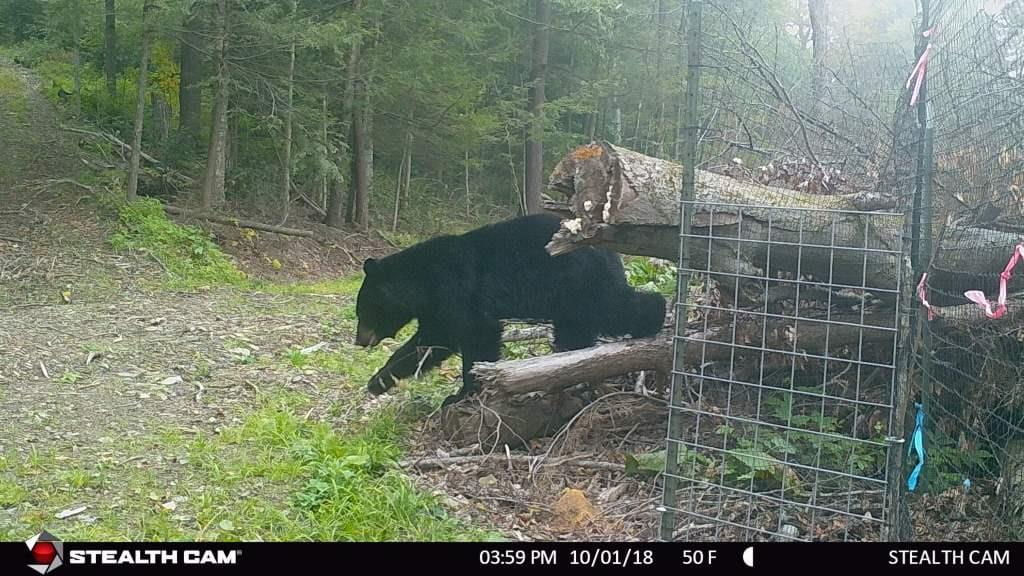 Aerial view of a slash wall at the Arnot Forest.
Aerial view of a slash wall at the Arnot Forest. Grapple skidder in the Camp Ridge harvest.
Grapple skidder in the Camp Ridge harvest. A nice example of the slash wall built around one of the first nine slash walls constructed at the Arnot Forest. As constructed, slash walls typically average about 10 feet tall and 20 feet wide.
A nice example of the slash wall built around one of the first nine slash walls constructed at the Arnot Forest. As constructed, slash walls typically average about 10 feet tall and 20 feet wide. One of many field tours to look north from the middle of the Gas Line harvest.
One of many field tours to look north from the middle of the Gas Line harvest. Foresters and loggers gather in September 2019 to learn about slash wall effectiveness and construction techniques.
Foresters and loggers gather in September 2019 to learn about slash wall effectiveness and construction techniques. A hard hat gives context to the size and composition of the southern edge of the Gas Line harvest.
A hard hat gives context to the size and composition of the southern edge of the Gas Line harvest. A image of the first section of slash wall built at the Arnot Forest. The eastern edge of the Gas Line harvest in early spring 2017.
A image of the first section of slash wall built at the Arnot Forest. The eastern edge of the Gas Line harvest in early spring 2017. The slash walls are imposing structures, almost monolithic, on the landscape.
The slash walls are imposing structures, almost monolithic, on the landscape. The North Gate slash wall, with a tree and educational sign for context.
The North Gate slash wall, with a tree and educational sign for context. Looking north from the middle of the Gas Line harvest, after two growing seasons.
Looking north from the middle of the Gas Line harvest, after two growing seasons.
 The first fall after construction of the slash wall on the Boot harvest, along Station Road.
The first fall after construction of the slash wall on the Boot harvest, along Station Road. A doe outside the freshly constructed North Gate Harvest gate.
A doe outside the freshly constructed North Gate Harvest gate. A doe and fawn outside the gate at the North Gate harvest. Note the livestock panel at the far edge of the mesh gate to exclude fawns from wandering into the access passage.
A doe and fawn outside the gate at the North Gate harvest. Note the livestock panel at the far edge of the mesh gate to exclude fawns from wandering into the access passage. The grapple skidder is able to collect bunches of stems piled by the feller buncher and transport to the landing.
The grapple skidder is able to collect bunches of stems piled by the feller buncher and transport to the landing. The feller buncher is efficient at harvesting timber and building walls.
The feller buncher is efficient at harvesting timber and building walls. A freshly built slash wall in the Boot or Wedge harvest
A freshly built slash wall in the Boot or Wedge harvest Many wildlife take advantage of the slash wall, and the early successional forest that is inside the slash wall.
Many wildlife take advantage of the slash wall, and the early successional forest that is inside the slash wall. The "Wedge" (pictured) and "Boot" harvests are downslope from Station Road. In this area there were about 30 - 35 beech trees > 15" dbh that had no evidence of beech bark disease (about 1/acre). They were surrounded by diseased beech. These "clean" beech were protected and isolated from diseased beech with a highly selective herbicide treatment prior to the harvest. Pin cherry has responded well in this harvest.
The "Wedge" (pictured) and "Boot" harvests are downslope from Station Road. In this area there were about 30 - 35 beech trees > 15" dbh that had no evidence of beech bark disease (about 1/acre). They were surrounded by diseased beech. These "clean" beech were protected and isolated from diseased beech with a highly selective herbicide treatment prior to the harvest. Pin cherry has responded well in this harvest. A grey fox found a way inside the Gas Line harvest and prowls the night for something to eat.
A grey fox found a way inside the Gas Line harvest and prowls the night for something to eat. A red fox found a way inside the Gas Line harvest and prowls the night for something to eat.
A red fox found a way inside the Gas Line harvest and prowls the night for something to eat. Black bears seem uninhibited by the wall. They have fortunately been willing to climb the wall rather than walk through the mesh. The wall may also provide foraging and overwintering habitat.
Black bears seem uninhibited by the wall. They have fortunately been willing to climb the wall rather than walk through the mesh. The wall may also provide foraging and overwintering habitat. A fisher sitting on the slash wall, perhaps looking for something to wander by and provide a meal.
A fisher sitting on the slash wall, perhaps looking for something to wander by and provide a meal. A doe and fawn outside the gate at the North Gate harvest. Note the livestock panel at the far edge of the mesh gate to exclude fawns from wandering into the access passage.
A doe and fawn outside the gate at the North Gate harvest. Note the livestock panel at the far edge of the mesh gate to exclude fawns from wandering into the access passage. A buck traveling on Irish Hill Road outside but adjacent to the North Gate slash wall.
A buck traveling on Irish Hill Road outside but adjacent to the North Gate slash wall. An image of the slash wall in the northeastern section of the Camp Ridge Harvest, with interior on the right.
An image of the slash wall in the northeastern section of the Camp Ridge Harvest, with interior on the right. Red oak and red maple retained as seed trees for a shelterwood "seed cut" in the Camp Ridge Harvest.
Red oak and red maple retained as seed trees for a shelterwood "seed cut" in the Camp Ridge Harvest. On the west slope of camp ridge, a nice residual stocking of red oak.
On the west slope of camp ridge, a nice residual stocking of red oak. The Recknagel North Harvest is about 6 acres and was completed in winter of 2019/2020. This area had considerable volumes of ash with early signs of Emerald Ash Borer activity. The soft ground conditions have been smoothed.
The Recknagel North Harvest is about 6 acres and was completed in winter of 2019/2020. This area had considerable volumes of ash with early signs of Emerald Ash Borer activity. The soft ground conditions have been smoothed. One of the more challenging topographies to build a slash wall. This is the Decker Road harvest. The interior is to the left and the exterior is to the right. The slash wall takes advantage of the steep slope on this glacial esker. Deer approaching from the left would need to leap upslope and over the wall. Given the topographic advantages and the lesser volume removed in this harvest, the walls are less robust.
One of the more challenging topographies to build a slash wall. This is the Decker Road harvest. The interior is to the left and the exterior is to the right. The slash wall takes advantage of the steep slope on this glacial esker. Deer approaching from the left would need to leap upslope and over the wall. Given the topographic advantages and the lesser volume removed in this harvest, the walls are less robust. Jack-in-the-pulpit and sugar maple seedlings are established and thriving in the understory of the Wedge Harvest. The shade is from red elderberry. Picture taken in May 2020.
Jack-in-the-pulpit and sugar maple seedlings are established and thriving in the understory of the Wedge Harvest. The shade is from red elderberry. Picture taken in May 2020. Jack-in-the-pulpit and sugar maple seedlings are established and thriving in the understory of the Wedge Harvest. The shade is from red elderberry. Picture taken in May 2020.
Jack-in-the-pulpit and sugar maple seedlings are established and thriving in the understory of the Wedge Harvest. The shade is from red elderberry. Picture taken in May 2020. The northern section of the Camp Ridge Harvest illustrating a shelterwood harvest 'seed cut."
The northern section of the Camp Ridge Harvest illustrating a shelterwood harvest 'seed cut." A grapple skidder working on the Camp Ridge Harvest.
A grapple skidder working on the Camp Ridge Harvest. More wildlife at the slash wall. An interaction between a red tail hawk and turkey.
More wildlife at the slash wall. An interaction between a red tail hawk and turkey.
